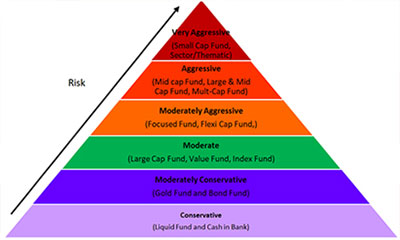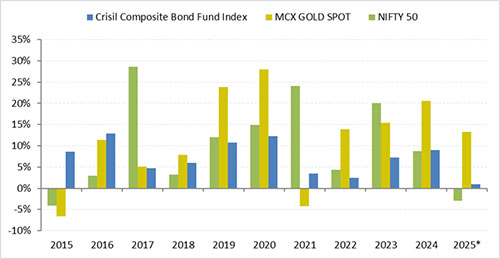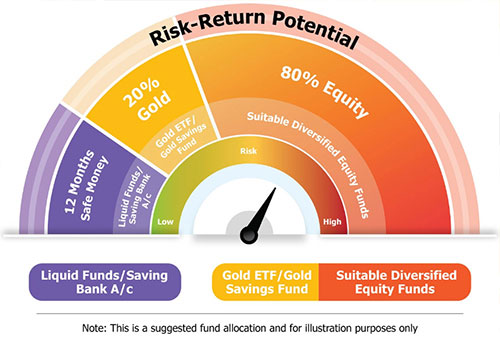Why You Need to Be Mindful of Asset Allocation in 2025 and Beyond
Rounaq Neroy
Feb 20, 2025 / Reading Time: Approx. 9 mins
Listen to Why You Need to Be Mindful of Asset Allocation in 2025 and Beyond
00:00
00:00
An old Spanish novel, Don Quixote by Miguel de Cervantes, carries a pearl of wisdom: "It is the part of a wise man to keep himself today for tomorrow, and not to venture all his eggs in one basket".
The hidden piece of advice in not putting all your eggs in one basket is averting the risk of losing everything by maintaining different baskets, i.e. by diversifying and following asset allocation.
Diversification and asset allocation are the foundation stones of investing. Harry Markowitz's Modern Portfolio Theory (MPT) also propagates the idea of diversification. It needs to be done not just within a respective asset class, but across asset classes. This is where asset allocation comes in.
Often, investors, going by their favourable past experiences tend to skew the portfolio to one particular asset class. After the COVID-19 pandemic lows, a lot of investors -- even those, in reality, having a moderate or low-risk appetite -- started investing in equities in the endeavour to earn better returns, overlooking the reality that past performance may or may not sustain and is in no way indicative of the future returns.
While Indian equities have demonstrated strong performance since the pandemic lows, there have also been phases or periods when the markets have eroded investors' wealth, such as the Harshad Mehta Scam of 1992, the dotcom bubble, the global financial crisis of 2008, and the initial period of the COVID-19 pandemic, among others.
The Indian equity market has once again hit turbulence, and volatility has intensified. This is because of a mix of domestic and global factors, viz. the tariff wars, weak Indian rupee against the greenback, rising bond yields, geopolitical tensions, potential geoeconomic fragmentation, supply chain disruptions, imported inflation, evident slowdown in consumption, corporate earnings having entered the slow lane of late, higher financing cost, climate risk events, and the potential impact of all these factors on economic growth.
It is also true that valuations in the Indian equity market are still lofty compared to global peers, which is why foreign investors are selling and looking for other markets to invest in. The trail Price-to-Equity (P/E) ratio of the MSCI Index is currently around 26x, while the MSCI Emerging Markets Index and MSCI World Index trail P/Es are around 15x each (as per the latest factsheets as of January 31, 2025). Although the market has corrected since its peak, it cannot be construed as cheap.
Table: India's Stock Market Valuations v/s Other Emerging Markets
 (Source: MSCI India Index Factsheet)
(Source: MSCI India Index Factsheet)
Even on a 12-month forward P/E, the MSCI India Index is commanding a noticeable premium vis-a-vis the MSCI Emerging Markets and the MSCI World Index (12-month forward P/E at 19.5x as of January 31, 2025).
In such times, you cannot be putting all your eggs in one basket. i.e. taking the risk only with equities as an asset class. Although India's long-term economic outlook seems bright, you need to be mindful of the risks in play and the potential impact on stock market or equity returns.
"The essence of investment management is the management of risks, not the management of returns," said Benjamin Graham (the father of value investing, the author of the famous book- The Intelligent Investor, and Warren Buffett's mentor).
Therefore, it would be imprudent to get carried away and to keep irrational return expectations.
In equities, currently, the risk is particularly high in the small-cap and mid-cap segments of the market, as their valuations are far higher than large-caps. In volatile and falling markets small-caps and mid-caps show the tendency to fall much more.
If you are already holding Mid Cap Funds and/or Small Cap Funds, it would be wise not to make fresh investments in the sub-category of equity mutual funds. That said, make sure the schemes you own are among the worthy or best ones.
Also, Mid Cap Funds and/or Small Cap Funds should ideally be a part of the satellite portion (up to 30-35%) of your equity mutual fund portfolio, wherein the allocation to a Small Cap Fund is limited to 10%-15% at this juncture.
Mid Cap Funds and/or Small Cap Funds, as a matter of strategy, currently, should not be in the core portfolio, plus to offset the impact of short-term volatility, keeping a time horizon of 8 years or more is important.
Image 1: Allocation Pyramid Based on Risk Profile
 Note: For illustration purposes only
Note: For illustration purposes only
You see, every type of mutual fund carries a certain level of risk. That risk needs to match or align well with your personal risk profile, which essentially defines what the ideal asset allocation should be.
The mutual fund schemes in the portfolio ought to be in harmony with your personal risk profile (classified as very aggressive, aggressive, moderately aggressive, moderate, moderately conservative, and conservative) rather than investing in an ad hoc manner in any mutual fund or just because a fund house has launched a new fund.
In the race to generate alpha or outperform the market, don't forget this important principle when investing. Not all mutual funds have been successful in generating alpha. In fact, in the last few years, generating alpha has been a real challenge for most of the active fund managers.
In the current volatile market conditions, it would be imprudent to expect alpha in the near term. The calendar year 2025 is proving to be a challenging one for Indian equities with global factors in play, India's consumption story slowing, reduced government spending, and downside risks to economic growth. Thus, it is important to set return expectations correctly considering the risk and not be unrealistic.
Graph: Year-on-Year Performance of Equity, Debt and Gold
 *Data as of February 18, 2025
*Data as of February 18, 2025
Past performance is not an indicator of future returns.
(Source: ACE MF, MCX, data collated by PersonalFN Research)
Understand that there will be times when the equity markets may not deliver expected returns. The graph above shows that the years 2015, 2016, 2018, and 2022 equities disappointed investors --either delivered negative returns or paltry returns.
Also, a fact is that the price movements across different asset categories do not move together in the same direction at the same time always. This further underscores the importance of asset allocation.
To balance the risk-return trade-off, investing across asset classes such as equity, debt, gold, real estate, or even holding cash, for that matter, is important. This is akin to putting eggs in different baskets, helping you to reduce the risk.
For tactical asset allocation to equity, debt, and gold, a Multi Asset Allocation Fund would also be a meaningful choice now.
If a prudent asset allocation model is defined or crafted (considering your age, risk profile, broader investment objective, financial goals and time in hand to achieve the envisioned goals), it could act as a shield and adduce the following key benefits:
-
Reduce dependence on a single asset class
-
Fairly diversify the portfolio
-
Serve as a safety measure when certain segments of the capital market are volatile
-
Lower the investment risk of your overall portfolio
-
Provide the freedom from timing the market
-
Ensure adequate liquidity of the portfolio
-
Potentially earn efficient inflation-adjusted returns
-
Help achieve the envisioned financial goals
In other words, following a prudent asset allocation model could prove as a strategy in itself.
Image 2: 12-20-80 Asset Allocation

Broadly, if you are young, your risk profile is reasonably high, and the investment objective is capital appreciation over the long term (7-8 years or more), you could follow a 12-20-80 Asset Allocation strategy, wherein you start off by setting aside 12 months of regular monthly expenses (including EMIs on loans) into a Liquid Fund and/or Savings Account (to address any exigencies), park 20% in gold as a portfolio diversifier (a hedge, plus a store of value in times of economic uncertainties), and the remaining 80% can be invested in suitable diversified equity funds as per your risk profile.
If you are not sure what your asset allocation model should be, reach out to a SEBI-registered investment adviser.
Keep in mind that asset allocation is not a static concept; it is dynamic. Meaning you cannot define it and forget it after you have invested accordingly. Asset allocation needs to be reviewed for it is possible that over time...
-
Your financial circumstance may have changed (for various reasons)
-
Your outlook towards money has evolved
-
The risk profile has altered
-
Inflation moved up faster than anticipated
-
Certain investments are underperforming or outperforming
-
You wish to adopt a change in investment style
-
The risk-return expectations have changed
-
Investment objectives today are different and/or
-
It may not be too long before the envisioned financial goals befall
As an investor, you need to be mindful of this and make alterations in the asset allocation model are done and the portfolio rebalancing is done accordingly.
A sensible approach is in the interest of your long-term financial well-being. So, be a thoughtful investor.
Happy Investing!
We are on Telegram! Join thousands of like-minded investors and our editors right now.
-New.png)
ROUNAQ NEROY heads the content activity at PersonalFN and is the Chief Editor of PersonalFN’s newsletter, The Daily Wealth Letter.
As the co-editor of premium services, viz. Investment Ideas Note, the Multi-Asset Corner Report, and the Retire Rich Report; Rounaq brings forth potentially the best investment ideas and opportunities to help investors plan for a happy and blissful financial future.
He has also authored and been the voice of PersonalFN’s e-learning course -- which aims at helping investors become their own financial planners. Besides, he actively contributes to a variety of issues of Money Simplified, PersonalFN’s e-guides in the endeavour and passion to educate investors.
He is a post-graduate in commerce (M. Com), with an MBA in Finance, and a gold medallist in Certificate Programme in Capital Market (from BSE Training Institute in association with JBIMS). Rounaq holds over 18+ years of experience in the financial services industry.
Disclaimer: Investment in securities market are subject to market risks, read all the related documents carefully before investing.
This article is for information purposes only and is not meant to influence your investment decisions. It should not be treated as a mutual fund recommendation or advice to make an investment decision in the above-mentioned schemes.